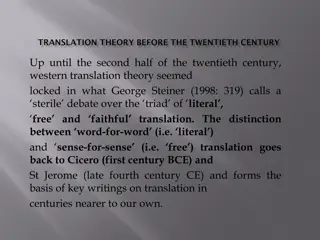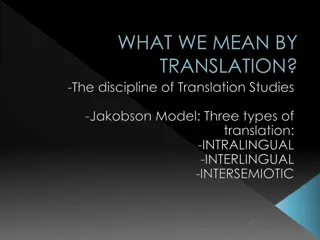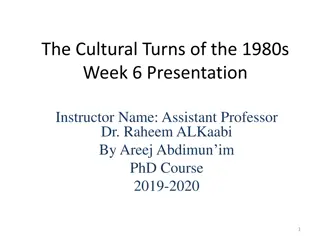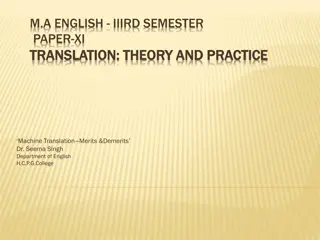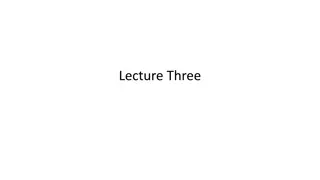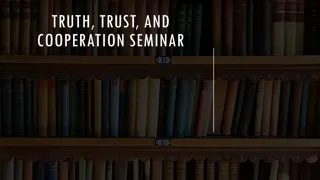Evolution of Dubbing in Audiovisual Translation
Dubbing is a major revoicing practice that involves replacing the original soundtrack with a TL recording synchronized to the actors' lip movements. The history of dubbing differs from subtitling and has evolved from poor quality single person dubbing to more sophisticated techniques like loop dubbing and unilinear dubbing.
Download Presentation

Please find below an Image/Link to download the presentation.
The content on the website is provided AS IS for your information and personal use only. It may not be sold, licensed, or shared on other websites without obtaining consent from the author.If you encounter any issues during the download, it is possible that the publisher has removed the file from their server.
You are allowed to download the files provided on this website for personal or commercial use, subject to the condition that they are used lawfully. All files are the property of their respective owners.
The content on the website is provided AS IS for your information and personal use only. It may not be sold, licensed, or shared on other websites without obtaining consent from the author.
E N D
Presentation Transcript
Dubbing is a form of major revoicing practice. It involves replacing the original soundtrack containing the performers dialogue with a TL recording that reproduces the original message, ensuring that the TL sounds and the actors lip movements are synchronized in such a way that target viewers are led to believe that the actors on screen are actually speaking their language. Dubbing is virtually restricted to the translation of films, TV series and sitcoms, children s programmes, and the sporadic commercial. (Diaz Cintas & Remael, 2006:98).
The history of dubbing differs from the history of subtitling and it varies from one country to another. This method of audiovisual translation first appeared in The United States although it has been used mainly in Europe, where it appeared in1936. (Diaz Cintas & Remael, 2006:98).
However, the first dubbing attempts started in the late 1930s. The quality of the dubbing process in these films was quite poor. Moreover, it was only one person who dubbed all the characters of the film and it was usually the translator himself. Some years later, several people started to perform post synchronization.
A. live dubbing evolution AVT. In this case the dubbing actors were the same as the actors of the film. The main problem of this technique of dubbing was that it was broadcast live and so the actors had no possibility of changing their version and the number of translation errors was usually very high. A. live dubbing : it was considered as an
B. loop dubbing divided into several parts or loops, all the actors present and they dub the film until the film director is satisfied. This method definitely has a better quality than the previous but it is very time-consuming. B. loop dubbing: in this kind, the whole film is
C. one actor dubbing his character from the beginning to the end until his film director is satisfied. In fact, in this case, if the film director is not satisfied they have to repeat only the part where the mistake was done. C. Unilinear Unilinear dubbing dubbing: Appeared in the1990s,
1. The phonetic synchrony: it is most widely known as lip synchrony which takes care of fitting the target text into the mouth openings of the onscreen characters, particularly in instances of close-ups. When working at this level, translators/dialogue writers must forget the sentence as their translational unit and concentrate on syllables and letters.
2. The second type of synchrony is that of the translation with the actors movements and gestures. The aim here is to guarantee that the dialogue does not contradict the image and that the shaking of a head comes accompanied by a negative statement. Finding adequate target voices that are compatible with the personality and the physical appearance of the person on screen is also part of this type of synchronization, though clearly a decision that is beyond the translator s reach
3. The third and last synchrony is known as isochrony and consists in making sure that the duration of the translated exchanges is in tune with the duration of the original ones and the utterances can be comfortably fitted between the moments the actors open and shut their mouth.
In the professional dubbing world, synchronization is prioritized above all else, and the quality of a translation is judged in terms of whether or not it it matches words, whether the translation corresponds both to the screen characters movements of the lips (lip synchrony), and particularly to the duration of the screen character s utterance, from the instant his or her mouth opens to speak to the instant it shuts (isochrony) matches the the lips lips , in other
According to Chion (1985: 74), the source of the sound is normally understood to be what is seen on screen something which dubbing changes drastically. This can mean that accepting dubbing is like ceasing to believe in the oneness of the individual . In dubbing, the original body is separated from its original voice, even if dubbed films give the illusion that the voice and the body are working together. This means that a dubbed voice changes pitch, articulation, class, regional context, colloquialisms, individual turns of phrase, timbre, educational levels and other suggestions of cultural positions and capabilities .
THANK YOU






